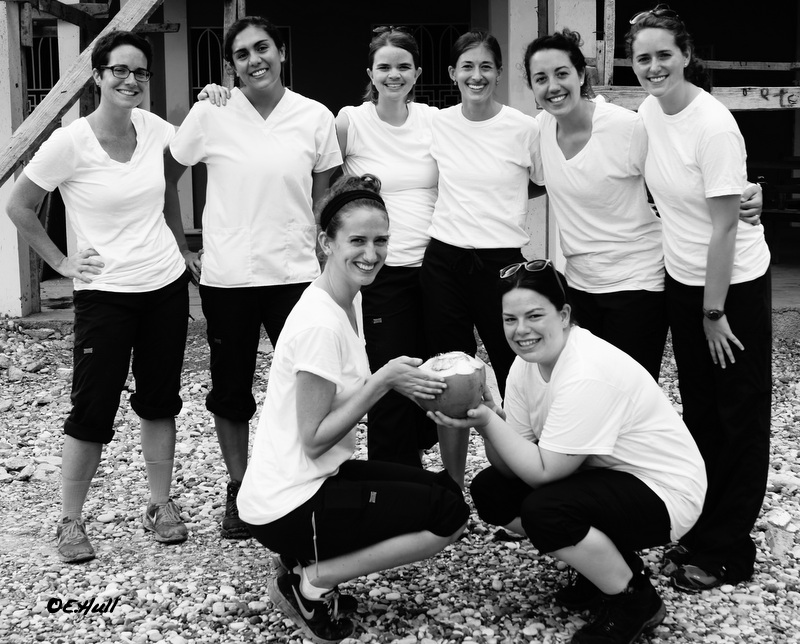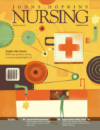
Tristin Hutchinson, Caitlin Dreisbach, Amy LeBailly, and Megan Armbruster pause for
coconut during their mission to Haiti.
“Is there a doctor or nurse on board?”
We had woken up bright and early for our 6 a.m. flight out of Baltimore-Washington International Airport and settled sleepily into our flight to Miami when the call came over the public address system. We meaning students Megan Armbruster, Emily DeVan, Caitlin Dreisbach, Nicolette Guerrero, Heather Holloway, Emily Hull, Tristin Hutchinson, and Amy LeBailly. The ultimate destination was Haiti, to work with our community partner Friends for Health in Haiti. While we snapped to attention, our clinical instructor, Grace Murphy, and a physician quickly assisted the ailing passenger.
Our adventure had officially begun.
Port-au-Prince greets travelers with such beautiful mountain vistas and turquoise seas. The Matthew 25 House offered a good night’s rest (rooster aside) and an indulgent breakfast. The next morning we drove to the local airport in Port-au-Prince among a frenzied mix of mopeds, tap-taps (the local taxi service), and pedestrians. We were able to fly between Port-au-Prince and Jèrèmie, where we would be staying for the remainder of our trip. Catherine Wolf, MD, and Cherlie Severe, RN, our hosts and founders of Friends for Health, greeted us at the airport in Jèrèmie.
We couldn’t wait—after a marathon of packing our donations, a last-minute fundraising bake sale, and all that flying—to see our work and preparation come to harvest.
The first weekend, there was a tour of the main hospital in Jèrèmie, visits to an orphanage to do crafts with children and a hospice to give care and massages to those nearing the end of life. At the start of the week, part of the group stayed at the Centre de Sante de Gatineau to help Wolf and Severe. The rest set off on a muddy, steamy, scrubs-testing, 90-minute hike to do interviews and discuss sanitation in surrounding villages. Since cholera has hit Haiti so hard, many of the interviewees had lost at least one person close to them. We talked about water sources in the community (such as natural springs), treating water (including Aquatabs, Clorox, and boiling) and where and how it’s stored. We were all touched by the stories that were shared with us. Throughout our trip we were amazed by the hospitality and kindness of our Haitian hosts. If not for community promoters such as Gemy and Phanor, who worked with Dr. Wolf, our trip wouldn’t have been a success.
A key part of that mission was helping to train “water and sanitation promoters” in ways to keep their villages safe from germs and water-borne illnesses. We’d been prepping since long before the trip. Over three days, we discussed the water cycle, and how water can get contaminated. Along the way we also discussed germ theory—using glitter to demonstrate how quickly “germs” spread—hand washing, treating water, building tippy-taps (a device for hand washing), and oral rehydration methods. The promoters had a chance to learn and practice teaching strategies they would use in their work. Of course, as in every other step of our journey, we learned from the Haitians as much as they learned from us. Too soon it was already time to go.
We returned to Baltimore to the news that we’d been awarded a Johns Hopkins Alumni Association grant, which will help fund medical and diagnostic equipment to help improve services offered at the Centre de Sante de Gatineau. We’re looking at cutting-edge technology that operates through an iPhone. What amazing technology! What an amazing journey!
Read more about the Haiti trip at blogs.nursing.jhu.edu.
– By Haiti Team 2013
